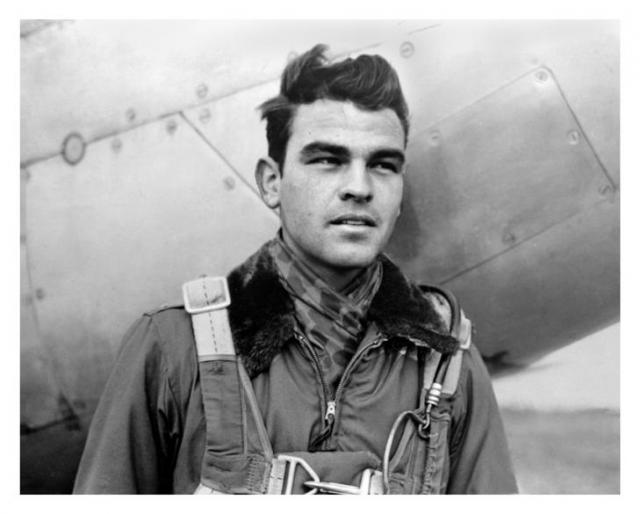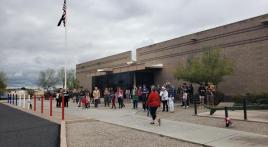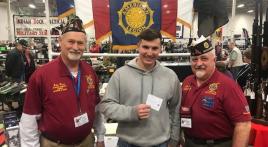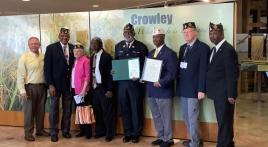Bill Preddy was following in the footsteps of his famous and older brother, George. He was flying the P-51 Mustang in aerial combat against Me 109s, FW 190s and the speedy Me 262 jet fighter. And he was flying the more dangerous missions involving attacks against ground targets such as enemy airfields.
Born in 1924, Bill was five years younger than George. He entered the Army Air Corps in 1943 and received his wings and commission on May 23, Class 44-E. Fred Baumann, a classmate, said that Bill never attempted to impress anyone by mentioning that his brother was a leading ace; he didn’t have to because “Bill was simply an impressive individual just by being himself.”
1942
Jan-Jun
Took temporary job at shipyard in Wilmington as welder’s helper.
June
Entered Texas A&M while visiting his aunt and uncle in Texas.
Sept
Entered N.C. State College. (While there, George came home from Australia and he and family visited Bill in Raleigh)
1943
Feb
At basic training center in Miami Beach, Fla.
April
At Indiana Central College’s Army Training Detachment near Indianapolis.
June
While at the College Training Detachment, made student commander of the 400-student post, the highest position a student can hold.
Aug 2
In San Antonio at a classification center “where they decide whether I’ll be a pilot, navigator or bombardier. Sure hope they decide it is pilot — fighter pilot.”
Aug 11
“Classified as pilot, and will probably go to Randolph for pre-flight training.”
Sept 11
“Still at Center in San Antonio. Taking radio code (Morse code), physical training and military orientation courses. Buying gum at the PX to send George. Mother is here visiting Uncle Bill, Aunt Nora and myself.”
Oct 30
“Finally leaving Center for Cuero, Texas, a primary training school 80 miles south of here.”
Nov 24
“Soloed this Thanksgiving Day.”
Dec 17
“Lots of fellows have washed out. I’m getting set to make my cross country flight — a highlight in primary training. It’s wonderful to be able to go out and get in a $15,000 airplane full of gas and take it up and buzz around for pay. The civvies pay $25 an hour to learn to fly one of these airplanes. It costs the government $27,000 to train a pilot.”
1944
Feb 2
“Still at Cuero.”
Feb 20
“At Waco, Texas for Basic Training. Trying for fighters. May have hard time since I’m up to 163 pounds, the heaviest I’ve ever been.” According to Fred Baumann, Bill was named the Cadet Group Commander, a distinct honor.”
Mar 16Again, Bill was appointed Cadet Group Commander at Moore Field. “Now at Moore Field, the fighter school in Mission, Texas, a little town near the Mexican border. Expecting Mother and Dad to come down for graduation. Aunt Nora and Uncle Bill are saving gas coupons so we can take them to Mexico. Will graduate May 23, Class 44-E.”
July
Bill came home on leave. After his leave he was sent to Venice, FL for further training in P-40s. George came home from England in September. So his Mother and he went to Venice to visit Bill. While there, George & Bill had a mock dog fight in two P-40s. After that flight, George said that “Bill was ready to take on the best the Luftwaffe had to offer.”
Dec 25
Bill came home on leave before departing for Europe. Although George was killed on Christmas Day 1944, the news did not reach home immediately, and Bill didn’t learn until the middle of January 1945. Coincidentally, Otto Gaskins, George’s best friend, got leave from the San Antonio Aviation Cadet Center and had Christmas dinner with Uncle Bill and Aunt Nora.
1945
Jan 23
Letter from Bill to home:
Dearest Mother & Dad,
As you know, I’ve been moving around pretty much but have been assigned to the 339th Fighter Group recently. It seems to be a very good outfit. The boys are tops and I’m flying Mustangs at last.
Yesterday I learned about George. Today I went to his home field and talked to many of the boys there.
What I have to say now is difficult to explain because I hardly understand it myself. There is no use to say not to grieve for I know that is impossible. It is useless to say try and forget, for we can’t and shouldn’t. We should remember, but in doing so we should look at it in the true light.
A man’s span on this earth is not measured in years. Above all, that is least important. To find happiness, success, and most important, to find God is the Zenith of any man’s worldly activities. I think a man has not lived until these things have been achieved. … Yes, George knew a full, rich life. He surely reached out and touched the face of God many times. …
I close offering you my eternal love and devotion. Let us carry on as George wanted and may we arrive at his standard.
Always love, /s/ Bill
March 2
On his seventh mission, Bill got a chance to see what he could do in aerial combat. Major William E. Bryan was leading the 503rd Fighter Squadron on an escort mission to Ruhland. Here is Bill’s Encounter Report:
I was flying Beefsteak Red #2 when we went down to attack approximately 20 FW 190s in the vicinity of Magdeburg. We pulled up behind the formation of enemy aircraft and Beefsteak Red Leader, Major Bryan, opened fire. The 190 he attacked peeled off into the undercast with flames pouring from his engine. I substantiate this claim for one FW 190 by Major Bryan.
Another 190 came in front of us and began turning in on our left and behind us. I turned into him and opened fire when I was in range; I kept firing until I saw his engine flame up and black smoke pour out. The Jerry then snapped over on his back and fell off into a spin burning fiercely; the pilot did not get out. I claim one FW 190 destroyed. I was looking around for my flight when an Me 109 came in on my left from above. We went into a Lufbery to the left and I opened fire slightly out of range but closing all the time. The Jerry tightened his turn but I dumped ten degrees of flaps and got my sight back on him. I saw strikes around the cockpit and tail which I believe killed the pilot because he dropped out of the Lufbery and went into a spin to the right. I followed him down very closely and as he hit the clouds at about 6,000 feet his ship began to disintegrate and pieces were flying off. I claim one Me 109 destroyed.
I was in a tight spiral when I broke out below the clouds at about 3,000 feet and immediately climbed back up to 14,000 feet where I bounced another 109.
Before I could get in range I was attacked from above and behind by two FW 190s and one Me 109 so I headed for home alone. I was forced to land on the Continent and, as my ship has not been ferried back yet, my film has not been entered and ammunition expenditure is unknown.
CLAIM:
One FW 190 Destroyed
One Me 109 Destroyed (later credited as a Probable)
Apr 17
Bill and his CO, Capt Raymond Reuter, gave chase to two Me 262 jets after strafing airfields at Klatovy and Eisendorf. They could not catch the 262s ; their chase led them to Ceske Budejovice – about 75 miles south of Prague – where they decided to make one last strafing run before going home. Both were shot down by enemy ground fire. Reuter’s aircraft exploded when hit. Bill’s Mustang crash landed at a small village (Zaluzi) where he was rescued by a Czech citizen, Jan Smejkal. Jan took him about five kilometers in a horse-drawn cart to a German emergency treatment center where he was given first aid only. Bill never regained consciousness. The German doctors refused to take Bill to the hospital in Ceske Budejovice. So Mr. Smejkal took him 10 more kilometers to the hospital where he died, probably on the 18th. He was buried on the 19th in a cemetery near the hospital. Later, his body was moved to the Lorraine American Cemetery near St. Avold, France and buried next to George.
SINCE WW II
Bill is remembered along with his more famous brother, George, who set records in the ETO: top Mustang ace, leading active ace when killed, first ETO pilot to shoot down six enemy fighters in one mission. Bill’s name appears on a bronze alumni plaque at NC State where he enrolled in September 1942; on a bronze alumni plaque at Greensboro (now Grimsley) High School. Bill is also remembered with his brother in exhibits in the Greensboro Historical Museum and in the terminal building at the Piedmont Triad International Airport. Incidentally, Bill is remembered in the 8th Air Force Heritage Museum in Savannah in a photo on display in the Pilots case. From left to right, the pilots are: Jeff French, Lee Scruggs, Bill Preddy, Ralph Hill, Bill Bryan and Alec Boychuck. Bill is also remembered in the Czech Republic where he is considered a hero because he was in on their liberation in 1945. Unfortunately, following the Communist coup of 1948, the liberation by the US Army was literally erased from all newspapers, school textbooks, and the minds of some Czech citizens. But not all; the Czechs have now built memorials to both Bill and his CO, Capt. Reuter since 1990. And they have established the Museum of the Air Battle Over Krusnohori where they have memorabilia of Americans from the 100th Bomb Group and the 339th Fighter Group, among others. It was in 1991 that Manuel Van Eyck wrote an article identifying Jan Smejkal as the one who pulled Bill from his Mustang after it crashed near Zaluzi. Joe Noah and his son, Bob, visited the sites in 2001 where Bill and George Preddy went down. They also visited the grave sites at Lorraine American Military Cemetery. Arnaud Beinat, a Frenchman from Metz, cares for the grave sites on ceremonial occasions for the Preddy Memorial Foundation.
2nd Addendum to George Preddy – Top Mustang Ace
Joe Noah
What Happened to Bill Preddy
This addendum is being issued because we have learned new facts that we did not have when we submitted the manuscript to Motorbooks International in 1990. All we knew about the demise of Bill Preddy and his CO, Captain Ray Reuter, when we wrote the manuscript was contained in the encounter reports of those flying with Bill and Ray the day they were reported missing, April 17, 1945. It was not until 1991 when the Czech Republic was once again liberated from the clutches of the Iron Curtain that a Czech citizen, Manuel Van Eyck, learned what happened on that fateful day in 1945. He wrote an article identifying the crash sites of both Mustangs near Ceske Budejovice, and Jan Smejkal as the one who pulled Bill from his Mustang after it crashed near Zaluzi.
Here is what we know now. On April 17th Bill and his CO, Captain Reuter, gave chase to two Me- 262 jets after strafing airfields at Klatovy and Eisendorf. Although the Me 262 is much faster than the Mustang by about 100 mph, on some occasions the Mustangs were successful in catching the short range Me-262s in their landing pattern. We suspect that is what Bill and Ray hoped for that day. However, apparently they did not catch the 262s ; their chase led them to Ceske Budejovice –– about 75 miles south of Prague –– where they decided to make one last strafing run before going home. Both were shot down by enemy ground fire. Reuter’s aircraft exploded when hit. Bill crash-landed at a small village (Zaluzi) where he was rescued by a Czech citizen, Jan Smejkal. Jan took him about five kilometers in a horse-drawn cart to a German emergency treatment center where he was given first aid only. We were told by Jan Smejkal that Bill never regained consciousness. The German doctors refused to take Bill to the hospital in Ceske Budejovice. So Jan took him 10 more kilometers to the hospital where he died, probably on the 18th. He was buried on the 19th in a cemetery near the hospital. Later, his body was moved to the Lorraine American Cemetery near St. Avold, France and buried next to George.
We have recently (2004-2006) learned that a German paratrooper by the name of Hans Gerlach was in the hospital in Ceske Budejovice as a patient when Bill was brought in by Jan Smejkal. We first learned that from Hans’ son who found the Preddy Memorial Foundation web site. It was from information in the web site that young Hans deduced that the pilot whom his father had helped in the hospital was in fact Bill Preddy.
Bill is remembered along with his more famous brother, George, who set records in the ETO: top Mustang ace, leading active ace when killed, first ETO pilot to shoot down six enemy fighters in one mission. Bill’s name appears on a bronze alumni plaque at NC State where he enrolled in September 1942; on a bronze alumni plaque at Greensboro (now Grimsley) High School. Bill is also remembered with his brother in exhibits in the Greensboro Historical Museum and in the terminal building at the Piedmont Triad International Airport. Incidentally, Bill is remembered in the 8th Air Force Heritage Museum in Savannah in a photo on display in the Pilots case. From left to right, the pilots are: Jeff French, Lee Scruggs, Bill Preddy, Ralph Hill, Bill Bryan and Alec Boychuck. Bill is also remembered in the Czech Republic where he is considered a hero because he helped liberate them in 1945. Unfortunately, following the Communist coup of 1948, the liberation by the US Army was literally erased from all newspapers, school textbooks, and the minds of some Czech citizens. But not all; the Czechs have now built memorials to both Bill and his CO, Capt. Reuter since 1990. And they have established the Museum of the Air Battle Over Krusnohori where they have memorabilia of Americans from the 100th Bomb Group and the 339th Fighter Group, among others. Joe Noah and his son, Bob, visited the sites in 2001 where Bill and George Preddy went down. They also visited the grave sites in Ceske Budejovice where Bill was initially buried, and at Lorraine American Military Cemetery where both brothers were finally interred. Arnaud Beinat, a Frenchman from Metz, adopted the grave sites and cares for them on ceremonial occasions for the Preddy Memorial Foundation.

Bill Preddy with his P-51 Mustang.
1st. Lt. William R. Preddy, fighter pilot
Clarksville, VA
June 28, 2017
Submitted by:
Joe Noah




